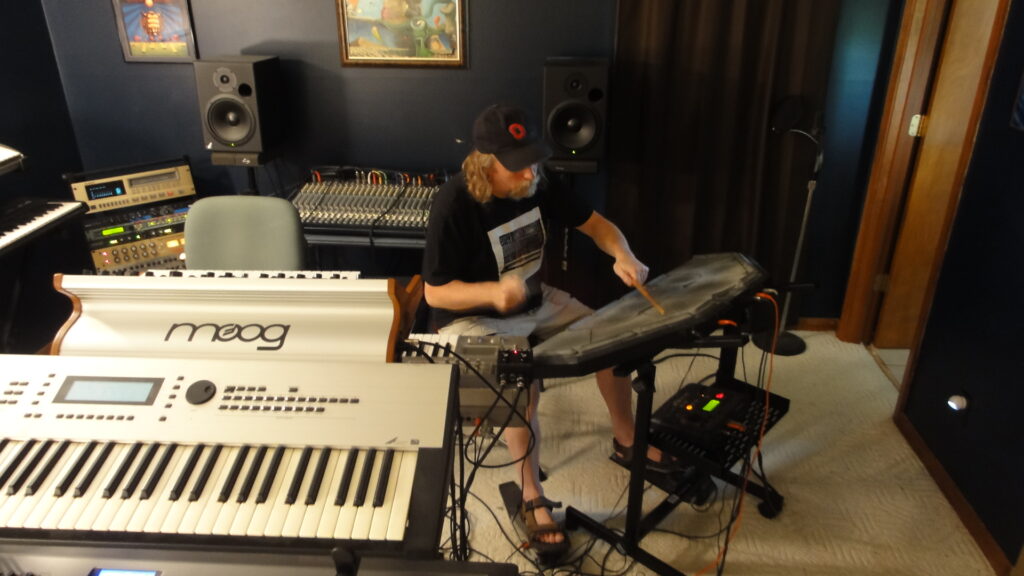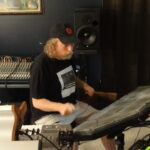Welcome to Side 1 of the studio production notes for the 2022 Church of Hed album, The Father Road. Check out the prologue, where we cover the studio setup, our recording philosophy, as well as the hardware and software gear used on the album. The prologue also includes background information on the entire Rivers of Asphalt project.

We separated these recording notes for The Father Road into four sides, ironic considering the lack of a vinyl release of the album. So feel free to dive right in to learn about the production approach of this double album.
Now, let’s cover Side 1, tracing the Lincoln Highway from San Francisco to Nevada’s border with Utah. Side 2 looks at the recording of this trip down the Lincoln Highway from Western Utah to the Mississippi River. Side 3 tracks the LH studio action through Illinois all the way to the Alleghenies. Side 4 chronicles the rest of our journey, from Bedford, PA to Times Square and beyond.
1. The Sea And Golden Gate (4:20)
The Sea And Golden Gate begins in the fog-laden seascape outside of San Francisco and its famous bay. The swirly strings and synths transverse the Golden Gate, leading to the syncopated intro: one of the first pieces written for the Rivers of Asphalt project nearly twenty years ago. Notably, Spitfire Audio’s top-shelf sample libraries make their first of many appearances during the brooding ambience of the intro.
The meat of this track underwent different changes over the last few years during its arrangement and recording. Transposing the root bass note throughout the track added some necessary tension and depth to the proceedings, while the generally busy nature of the piece reflects the Lincoln Highway traveling through San Francisco itself. I held back on adding a separate drum track to foster a minimalist approach to the mixing, but I sometimes want to go back and add some overdubs. Music is mutable after all. By the way, note the fortuitous accident of the track length!
2. Sierra Ascent 1 (2:48)
We considered combining the three Sierra tracks into one, but ultimately decided to keep them separate. All three leverage a similar chord structure – all four California tracks do in a sense – with this first version focused on solo piano, road atmospherics, and eventually a melody using a trumpet from Spitfire Audio’s LABS.
In fact, the recording of Sierra Ascent 1 happened last since I wanted a mellow interlude between San Francisco and climbing the Sierras. I played the chord progression from the in-progress Sierra Ascent 2 and wrote and overdubbed the trumpet melody. This melody reappeared on Sierra Ascent 2, played by the Moog Sub 37 MIDI’d with a Make Noise 0-Coast – the “MoogCoast” –. A bit of road atmospherics from the Modal Electronics Skulpt SE finished out the overdubs on this track.
3. Sierra Ascent 2 (2:18)
On the album, I wanted to use a similar motif for the mountain sections of The Father Road: effectively the Sierras, the Wasatch, and the Alleghenies. After all, it’s the same Lincoln Highway. It needed to be something with a swampy drum machine pattern allowing a Levon Helm-inspired groove over the top. A sense of climbing was also important. The Arturia DrumBrute analog drum machine provided the right feel and sound, with Acustica’s Cream plugin offering the old-school tube EQ.
The MoogCoast handled both the synth bass and lead roles. Stan Lyon’s bass work served as the special sauce for this groovy ascent on the LH to Truckee. The crest of the Sierras awaits us.
4. Sierra Crest (3:49)
The bulk of Sierra Crest appeared suddenly out of an improvisation during one session. A fortuitous Moog arpeggiation serves as the pulse of the track. The Waldorf Streichfett MIDI’d with the Korg Z1 restates that same California chord progression heard in the previous three tracks.. XILS-Lab’s XILS 4 shined in the role of analog-sounding synth effects overdubs.
The relative simplicity of this track made mixing an ease and it remains my favorite track on The Father Road. Real-time synth improv as found on Sierra Crest always serves as a respite compared to our pieces featuring more left-brained composition. It just might be my new focus moving forward. Still, I’ve had a difficult time trying to perfectly recreate the Moog arpeggiation when playing this track live in the studio.
5. The Loneliest Highway (8:39)
The album now travels the Lincoln Highway on Nevada’s famous Loneliest Highway at nighttime under Nevada stars. This track shares a sonic palette with Rivers of Asphalt’s Enchanted Mesa, which transverses Route 66 in the New Mexican desert. On both, a minimal bass synth sequence serves as a bed for a landscape filled with droning sounds and effects. The Moog Sub 37 provided that sequence on The Father Road track.
As work on the track continued, a critical change in the sequence and the delay time on the Moog MF Delay pedal happened, enhancing the sense of loneliness throughout the entire track. Stan rerecorded his trippy bass chord part using a similar technique as the first version of the track. A distorted piano – thanks to the Elektron Analog Drive pedal – and the standard array of string synth and effects round out The Loneliest Highway’s sonics.
Stay tuned for the final three installments to the recording notes chronicling the production of Church of Hed’s The Father Road.

[…] As a prologue, let’s provide a few insights on The Father Road album itself and our recording setup, including the DAW, studio gear, and other items relating to the album’s production. In the other four articles, we’ll dive into each track and the bespoke recording approach making each a sonic reality. Enjoy the journey. Check out Side 1! […]